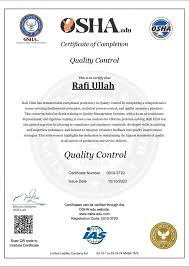Unlocking Career Opportunities with OSHA Certification

Understanding OSHA Certification
OSHA, which stands for the Occupational Safety and Health Administration, plays a crucial role in ensuring workplace safety across various industries. OSHA certification is a valuable credential that demonstrates an individual’s knowledge and understanding of occupational safety standards and regulations.
Obtaining OSHA certification involves completing training programs that cover topics such as hazard recognition, emergency response procedures, workplace ergonomics, and more. These programs are designed to equip workers with the necessary skills to identify and mitigate workplace hazards, ultimately promoting a safer work environment for all.
Employers often prioritize hiring individuals with OSHA certification as it showcases a commitment to safety and compliance with regulations. Additionally, having OSHA-certified employees can lead to reduced incidents of workplace injuries and illnesses, lower insurance premiums, and improved overall productivity.
Whether you are a seasoned safety professional looking to enhance your credentials or a new employee seeking to establish a strong foundation in workplace safety, pursuing OSHA certification can benefit both your career growth and the well-being of your colleagues.
By investing in OSHA certification, individuals demonstrate their dedication to creating safe and healthy work environments while also contributing to the overall success of their organizations.
5 Essential Tips for Achieving and Maintaining OSHA Certification
- Ensure you understand OSHA regulations and standards thoroughly.
- Provide proper training to employees on workplace safety procedures.
- Regularly inspect the workplace for potential hazards and address them promptly.
- Maintain accurate records of safety training and incidents as required by OSHA.
- Stay updated on any changes in OSHA regulations to ensure compliance.
Ensure you understand OSHA regulations and standards thoroughly.
It is essential to ensure a comprehensive understanding of OSHA regulations and standards when pursuing OSHA certification. By familiarizing oneself with these guidelines, individuals can effectively identify workplace hazards, implement appropriate safety measures, and maintain compliance with legal requirements. Thorough knowledge of OSHA regulations not only enhances workplace safety but also demonstrates a commitment to creating a secure environment for all employees.
Provide proper training to employees on workplace safety procedures.
Providing proper training to employees on workplace safety procedures is a fundamental aspect of OSHA certification. By ensuring that employees are well-versed in hazard recognition, emergency response protocols, and other essential safety practices, organizations can create a safer work environment and reduce the risk of accidents or injuries. Comprehensive training not only enhances employee awareness but also empowers them to take proactive measures to prevent potential hazards. Ultimately, investing in thorough safety training demonstrates a commitment to prioritizing employee well-being and regulatory compliance, leading to a more secure and productive workplace for all.
Regularly inspect the workplace for potential hazards and address them promptly.
Regularly inspecting the workplace for potential hazards and promptly addressing them is a fundamental aspect of maintaining a safe and healthy work environment. By conducting thorough inspections, employers can identify risks such as slippery floors, faulty equipment, or inadequate safety protocols that could lead to accidents or injuries. Addressing these hazards in a timely manner not only helps prevent incidents but also demonstrates a commitment to employee well-being and compliance with OSHA regulations. Proactive hazard identification and mitigation contribute to a safer workplace for all employees, fostering a culture of safety and reducing the likelihood of workplace accidents.
Maintain accurate records of safety training and incidents as required by OSHA.
It is essential to maintain accurate records of safety training and incidents as required by OSHA. Keeping detailed documentation of safety training sessions ensures that employees are adequately informed and prepared to handle workplace hazards effectively. Additionally, recording incidents helps track patterns, identify potential risks, and implement preventive measures to enhance overall workplace safety. By diligently documenting safety training and incidents, organizations demonstrate their commitment to compliance with OSHA regulations and prioritize the well-being of their employees.
Stay updated on any changes in OSHA regulations to ensure compliance.
Staying updated on any changes in OSHA regulations is crucial to maintaining compliance and promoting a safe work environment. By staying informed about the latest updates and revisions to OSHA standards, individuals with OSHA certification can ensure that their knowledge and practices align with current requirements. This proactive approach not only demonstrates a commitment to workplace safety but also helps prevent potential violations and penalties. Regularly monitoring and adapting to changes in OSHA regulations is key to upholding the highest standards of safety in the workplace.


Leave a Comment